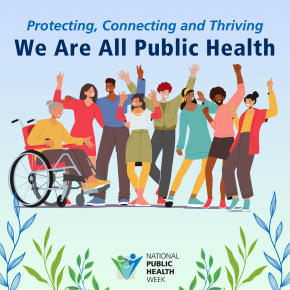Protecting, Connecting and Thriving: We Are All Public Health

Public health is more than just health care. It’s making sure our food and water are safe to eat and drink. It’s also the relationships we foster in our communities. We’re all interconnected. When we all come together to support public health, all of us – individuals, families, communities and the public health field – can achieve the goals of public health.
New Tools and Innovations
Public health is all about preventing disease, diagnosing health conditions and encouraging health and well-being. However, achieving these goals wouldn’t be possible without the help of new tools and innovations in public health. From wearable fitness bands to virtual doctors’ appointments, new technology, has changed the way individuals and communities receive and respond to health information. Other tools, like warning systems for natural disasters or COVID-19 testing kits, can help individuals stay connected and protected during emergencies. Advancements in public health can help us in the fight towards equity, so all people and populations can thrive.
Healthy Neighborhoods
We know that where we live – where we eat, sleep, work, play, learn and pray – can have a huge effect on our health. But what makes a neighborhood healthy? Having safe places to live, without hazards or pollution. Having safe ways for everyone to be active, like sidewalks, and safe places to bike. Having easy access to fresh, affordable, nutritious and culturally appropriate food. When our neighborhoods are healthy, we have the building blocks for healthy lives.
Emergency Preparedness
Unexpected events such as power outages and natural disasters like earthquakes and hurricanes can happen without a moment’s notice. That is why being ready for emergencies is crucial. Emergency preparedness is exactly what it sounds like; it involves planning, having supplies on hand and knowing how to stay safe during an emergency. Being ready for crises before they happen can not only protect you and your loved ones but also underserved communities where disasters can worsen inequities.
Floyd Valley Newsletter
By submitting this form, you are consenting to receive marketing emails from: . You can revoke your consent to receive emails at any time by using the SafeUnsubscribe® link, found at the bottom of every email. Emails are serviced by Constant Contact